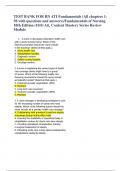-
1. Exam (elaborations) - Ati fundamentals proctored exam 2019/2020 retake guide ati fundamentals exam real ex...
-
2. Exam (elaborations) - Ati fundamentals proctored exam 2019/2020 retake guide ati fundamentals exam real exa...
-
3. Exam (elaborations) - Ati pn mental health proctored exam (18 new versions, 2021) / ati pn proctored mental...
-
4. Exam (elaborations) - Nur psychiatri hesi-mental-health-rn-v1-v3- 2023/2024- hesi mental health rn v1-v3 la...
-
5. Exam (elaborations) - Ati fundamentals proctored exam test bank latest updated examination study guide 2022
-
6. Exam (elaborations) - Hesi fundamentals exam 12 latest complete version & latest update 2022/2023 guide ...
-
7. Exam (elaborations) - Hesi rn mental health rn v1-v3 exam elaborations questions & answers latest update 20...
-
8. Exam (elaborations) - Ati fundamentals proctored exam | questions and answers with rationales | latest 2023...
-
9. Exam (elaborations) - Ati rn fundamentals online practice 2019 a with ngn
-
10. Exam (elaborations) - Fundamentals proctored exam 2019 retake 1
-
11. Exam (elaborations) - Mental health test 1 review
-
12. Exam (elaborations) - Ati pn fundamentals proctored exam (11 latest versions,latest update 20232024) / pn a...
-
13. Exam (elaborations) - Fccs (fundamentals of critical care support) questions with correct answers graded a+
-
14. Exam (elaborations) - Ati mental health proctored 2019 exam form b latest questions with verified correct a...
-
15. Exam (elaborations) - Ngn ati mental health proctored 2019 exam form b latest questions with verified corre...
-
16. Exam (elaborations) - Ati rn mental health 2019/mental health ati160 questions and 100% correct answers
-
17. Exam (elaborations) - Ati mental health proctored retake exam 2019/ 73 questions with updated correct solut...
-
18. Exam (elaborations) - Ati rn fundamental real exam 2023 / 2024 latest update
-
19. Exam (elaborations) - Ati rn fundamentals rn exam testbank 402questions and answers with rationales latest ...
-
20. Exam (elaborations) - Ati fundamentals proctored exam | questions and answers with rationales | latest 2023...
-
21. Exam (elaborations) - Answers midterm exam - nr 565 ( latest 2023 / 2024 ) study guide (notes week 1 – 4)...
-
22. Exam (elaborations) - [ngn] ati fundamentals proctored exam2023 retake (all questions correctly answered) a...
-
23. Exam (elaborations) - Ati fundamentals exam questions and answers with rationales latest 2021/ 2022 ati fun...
-
24. Exam (elaborations) - Fundamentals of nursing 9th edition by taylor, lynn, bartlett test bank | chapter 1-4...
-
25. Exam (elaborations) - Ati fundamentals proctored exam test bank latest updated examination study guide 2022...
-
26. Exam (elaborations) - Wgu d072 fundamentals for success in business pre assessment with correct answers. w...
-
27. Exam (elaborations) - Ati rn mental health 2019 with ngn 100% pass with rationales latest updates question ...
-
28. Exam (elaborations) - Ati mental health proctored newest 2023-2024 actual test 180 questions and correct de...
-
29. Exam (elaborations) - Ati - mental - health - proctored - retake = 2019 - reliable with verified questions ...
-
30. Exam (elaborations) - Fundamentals of nursing active learning for collaborative practice 3rd edition yoost ...
-
31. Exam (elaborations) - Test bank for fundamentals of nursing 10th edition 2023 by taylor chapter 1-47 | comp...
-
32. Exam (elaborations) - Test-bank for varcarolis' foundations of psychiatric-mental health nursing=9th editio...
-
33. Exam (elaborations) - Rasmussen mental health = final exam questions with 100% correct answers latest updat...
-
34. Exam (elaborations) - Fundamentals of nursing 10th edition potter perry test bank chapter 1. nursing today
-
35. Exam (elaborations) - Test bank for rn ati fundamentals (all chapters 1- 58 with questions and answers)/fun...
-
36. Exam (elaborations) - Ati mental health lpn retake exam 2023 update
-
37. Exam (elaborations) - Ati mental health lpn retake exam 2023 update
-
38. Exam (elaborations) - Ati mental health proctored ati, ati proctored mental health study guide
-
39. Exam (elaborations) - Ati mental health a 2019 proctored exam
-
40. Exam (elaborations) - Ati pn mental health proctored exam (18 new versions, 2021) / ati pn proctored mental...
-
41. Exam (elaborations) - Ati mental health proctored exam 2019 1 / 9
-
42. Exam (elaborations) - Ati_mental_health_b_2019
-
43. Exam (elaborations) - Capstone quiz assessment mental health question and answers latest update 2023
-
44. Exam (elaborations) - 2023 rn mental health online practice 2023 b with ngn graded a+
-
45. Exam (elaborations) - Test-bank for davis advantage for townsends essentials of psychiatric mental health n...
-
46. Exam (elaborations) - Ati fundamentals proctored exam | 400+ questionsand 100% verified answers with ration...
-
47. Exam (elaborations) - 2023 ati mental health form a & form b with ngn proctored 2023-2024 exam (140 q & a)/...
-
48. Exam (elaborations) - Ati mental health a and b
-
49. Exam (elaborations) - Nur 256 mental health exam 1-5 updated 2023-2024 practice guide
-
50. Exam (elaborations) - Ati mental health proctored test bankwith ngn 2023 questions and correct answers and ...
-
51. Exam (elaborations) - 2023 ati fundamentals proctored retake exam 2 versions each with 70 questions and ngn...
-
52. Exam (elaborations) - Az-900: microsoft azure fundamentals exam cram dwayne natwick cloud training architec...
-
53. Exam (elaborations) - 2023/2024 all hesi fundamentals exam test bank updated question with rationales and a...
-
Show more




